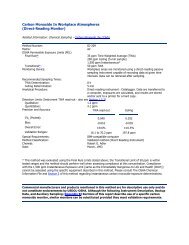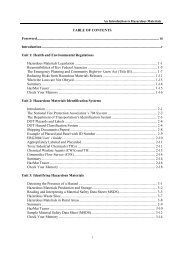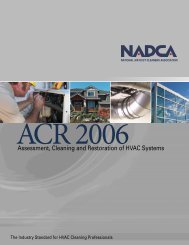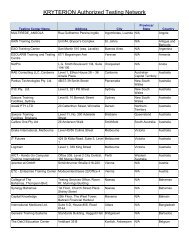Dampness and Mould - WHO guidelines for indoor air quality - PRWeb
Dampness and Mould - WHO guidelines for indoor air quality - PRWeb
Dampness and Mould - WHO guidelines for indoor air quality - PRWeb
You also want an ePaper? Increase the reach of your titles
YUMPU automatically turns print PDFs into web optimized ePapers that Google loves.
HEALTH EFFECTS ASSOCIATED WITH DAMPNESS AND MOULD<br />
91<br />
frequency of respiratory infections associated with damp buildings might be explained<br />
by the immunosuppressive effects of damp building-associated microbes<br />
in experimental animals, which imp<strong>air</strong> immune defences <strong>and</strong> thus increase<br />
susceptibility to infections. An alternative explanation might be that inflamed<br />
mucosal tissue provides a less effective barrier, increasing the risk of infection.<br />
Demonstration of such effects in cells or experimental animals at levels of microbial<br />
exposure similar to those in <strong>indoor</strong> environments would allow extrapolation<br />
of these results to human beings.<br />
Various microbial agents with diverse, fluctuating inflammatory <strong>and</strong> toxic<br />
potential are present simultaneously with other <strong>air</strong>borne compounds, inevitably<br />
resulting in interactions in <strong>indoor</strong> <strong>air</strong>. Such interactions may lead to unexpected<br />
responses, even at low concentrations. There<strong>for</strong>e, the detection of individual<br />
exposures, such as certain microbial species, toxins or chemical agents, cannot<br />
always explain any associated adverse health effects. In the search <strong>for</strong> causative<br />
constituents, toxicological studies should be combined with comprehensive<br />
microbiological <strong>and</strong> chemical analyses of <strong>indoor</strong> samples.<br />
The synergistic interactions among microbial agents present in damp buildings<br />
suggest that the immunotoxic effects of the fungal <strong>and</strong> bacterial strains<br />
typically found can be potentiated during concomitant exposure, leading, <strong>for</strong><br />
instance, to increased cell death or cytotoxic or inflammatory effects. Such interactions<br />
can give rise to unexpected responses, even at low concentrations of microbial<br />
(or chemical) agents, so that it is difficult to detect <strong>and</strong> implicate specific<br />
exposures in the causation of damp building-associated adverse health effects.<br />
Thus, microbial interactions must be carefully considered when evaluating the<br />
possible health effects of exposure in damp buildings. Differences in the concentrations<br />
used in studies with cell cultures or experimental animals <strong>and</strong> those that<br />
may be reached by human beings should also be kept in mind when interpreting<br />
the findings.<br />
Most of the relevant toxicological data from studies in experimental animals<br />
refer to the immunotoxicity of fungi, especially the species S. chartarum <strong>and</strong> its<br />
toxins. The role of other microbial exposures, including dampness-related bacteria,<br />
requires more study. For the identification of causative constituents <strong>and</strong> risk<br />
assessment, toxicological <strong>and</strong> epidemiological data should be combined with<br />
microbiological <strong>and</strong> chemical analyses of <strong>indoor</strong> <strong>air</strong> samples. In interpreting the<br />
results of studies in experimental animals in relation to human exposures, it is<br />
important to consider differences in relative doses <strong>and</strong> the fact that the exposures<br />
used <strong>for</strong> experimental animals may be orders of magnitude higher than those<br />
found in <strong>indoor</strong> environments.<br />
The available estimates, based on the assumption that the associations found<br />
in the epidemiological studies are unbiased <strong>and</strong> causal, suggest that dampnessrelated<br />
risk factors are associated with a large proportion of human respiratory<br />
disease. For instance, residential dampness is associated with a 50% increase in






